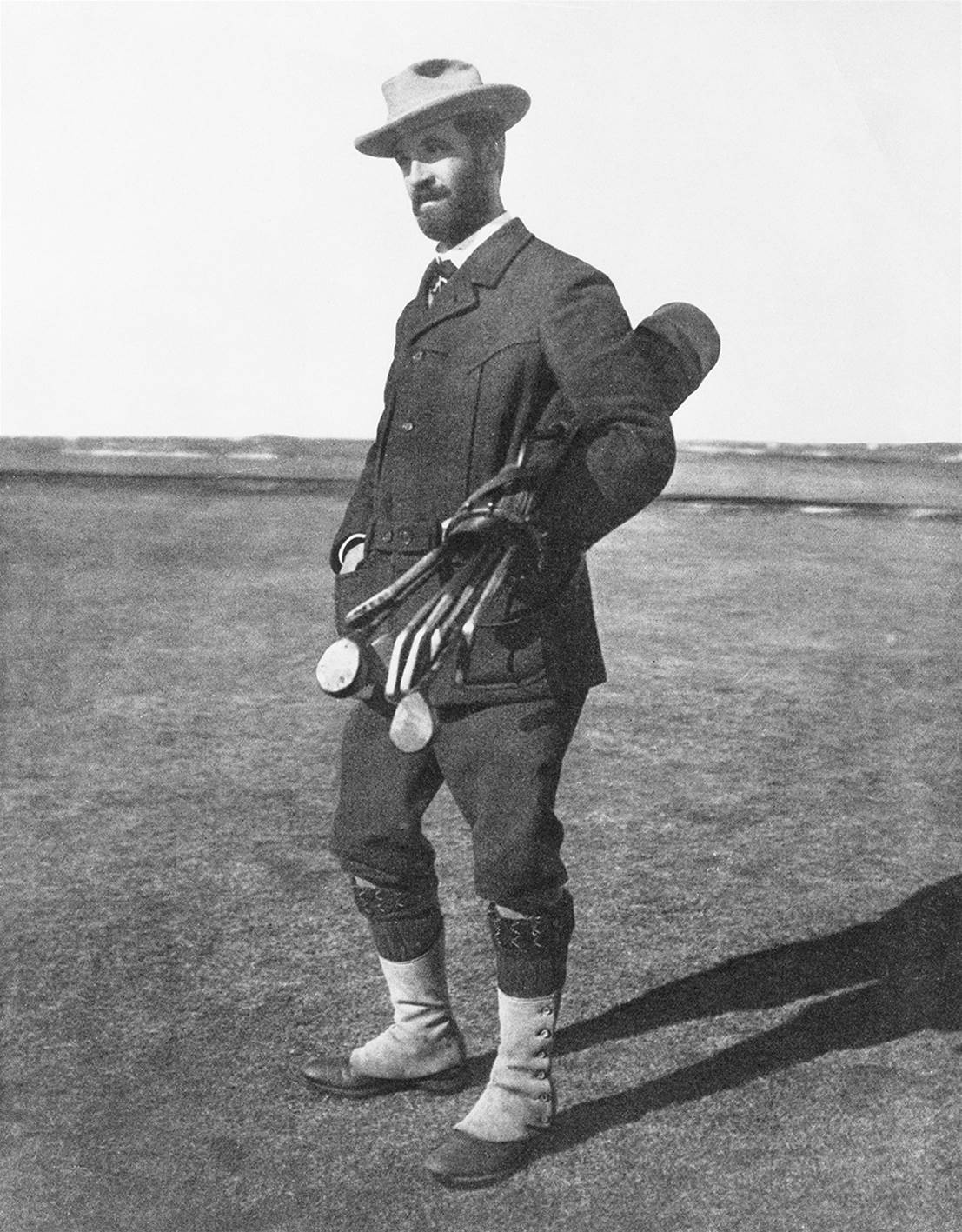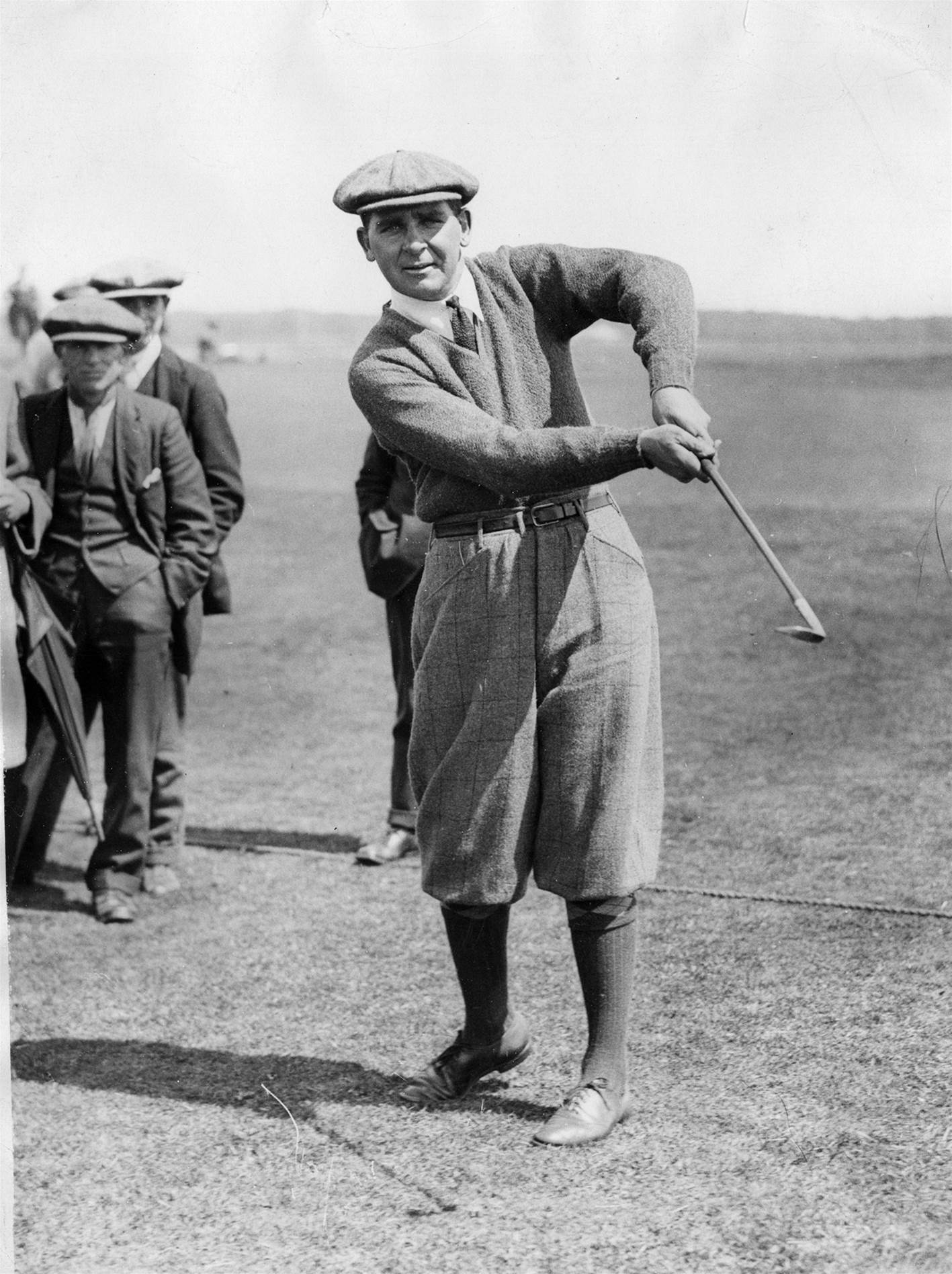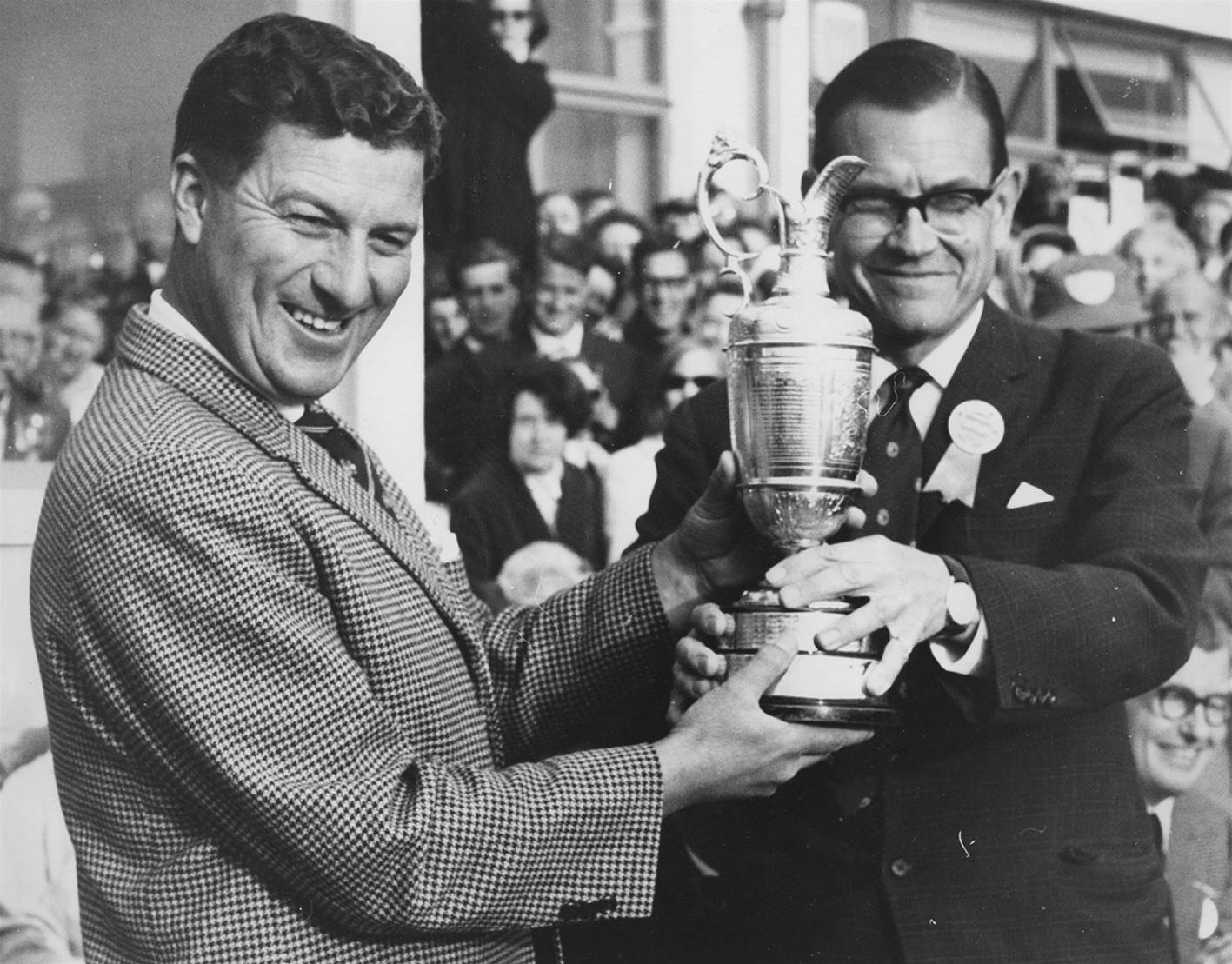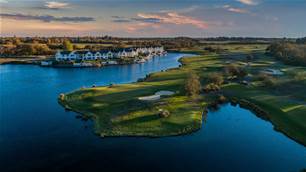Australian golfers have a rich history at The Open Championship.
Ask any of our elite players to name the major championship title they covet most and The Open always gets a look in.
Perhaps it is the past triumphs of Peter Thomson, Greg Norman and Ian Baker-Finch that have fuelled the dreams of our aspiring Open winners. Or is it the courses and the type of golf required to win on them? Or, is it as simple as wanting to win the trophy that nearly every great player in the history of the game has won? It’s probably a combination of all three.
Australia’s first strong connection with The Open Championship dates back to 1904 and the same venue that will host this week’s championship, Royal St. George’s.
 Walter Travis was born in Maldon, Victoria, and emigrated to the United States as a 23-year-old sales representative of a hardware and construction company. He played his first game of golf in 1896, aged 35, and won the first of three U.S Amateur Championships just five years later.
Walter Travis was born in Maldon, Victoria, and emigrated to the United States as a 23-year-old sales representative of a hardware and construction company. He played his first game of golf in 1896, aged 35, and won the first of three U.S Amateur Championships just five years later.
In 1904, Travis (pictured right) travelled to England and won the British Amateur before taking his place in the field for The Open, where he missed the cut.
When The Open returned to Royal St. George’s in 1911, a two-time Australian Open Champion was in the field.
The Hon. Michael Scott – the son of John Scott, Earl of Eldon – was 22-years-old when he emigrated to Australia from England. He won most of the major amateur events in Australia, including the national title four times, and claimed the inaugural Australian Open in 1904. He won it again in 1907, just before returning to England.
Scott played in the 1911 and 1912 Opens, finishing T41 and T37 respectively. After serving in World War I, Scott played two more Open Championships with his best result coming in 1922 when he finished T20. He went on to make headlines in 1933 as the oldest winner of The Amateur Championship, aged 54.
 Australia’s first real chance to celebrate an Open Champion came in 1921 at St. Andrews, the same year Bobby Jones made his Open debut and walked off during the third round after taking four shots to get out of Hill Bunker on the 11th hole.
Australia’s first real chance to celebrate an Open Champion came in 1921 at St. Andrews, the same year Bobby Jones made his Open debut and walked off during the third round after taking four shots to get out of Hill Bunker on the 11th hole.
Sydney professional Joe Kirkwood – a year after winning the Australian and New Zealand Open double – undertook the arduous journey to the Home of Golf where he finished T6, six strokes behind winner Jock Hutchison, after a disastrous final round 79.
It wasn’t the last time Kirkwood (pictured right) would have the Auld Claret Jug in his sights only to falter at the final gasp.
At Royal Troon in 1923, he led with a handful of holes to play before stumbling to a closing 78 and a fourth-place finish, three behind English pro Arthur Havers. And, again, in 1927 (St. Andrews) and 1934 (Royal St. George’s), Kirkwood had a top-five result but in both championships the field were playing for second behind Bobby Jones and Henry Cotton respectively.

When The Open resumed after World War II, it seemed like only a matter of time before Queensland’s Norman von Nida would win the Claret Jug. Between 1946 and 1948, ‘The Von’ finished T4, T6 and T3 but a victory in the championship would unfortunately elude him. That wasn’t the case for one young player von Nida mentored in his early days playing the British circuit.
Peter Thomson became the first Australian to win The Open in 1954 at Royal Birkdale. Runner up finishes in the two previous years had steeled a young Thomson in the ways of winning an Open and he did so with aplomb, getting up-and-down for par twice from difficult bunker lies in the last three holes to claim the trophy by a stroke from Welshman Dai Rees, South African Bobby Locke and England’s Syd Scott.

Thomson’s Open victory began a lengthy period of domination at the championship. Royal Birkdale was the first of three consecutive wins, before finishing runner up to Locke in 1957 at St. Andrews. He did, however, claim his fourth Claret Jug in 1958 and a fifth in 1965, again at Royal Birkdale.
In the middle of that Thomson run was the Centenary Open win by his good mate, Kel Nagle. Nagle, then 39, had to overcome the rain, the cold and a charging Arnold Palmer to claim the Jug by a single stroke and put an end to the American’s Grand Slam aspirations. In the nine years following his win, Nagle had a further six top-10s in the championship.

Thomson made his last regular Open Championship appearance in 1979 at Royal Lytham, aged 50, and finished T26. In the 20 years between his Open debut in 1951 and 1971, Thomson had five victories and 13 top-10 finishes and never missed a cut during those two decades.
Despite the depth of talent playing in America and Europe in the 1970s, there was only one real chance for an Australian victory at The Open.
That was in 1975 when Jack Newton – whose two previous Open appearances yielded missed cuts – opened with a solid three under 69, as did his mate Bob Shearer, to sit one stroke from the lead. Despite a second round 71, Newton found himself drifting back into the pack. But a course record 65 in the third round at Carnoustie catapulted the Novacastrian back into contention, just a stroke adrift of 54-hole leader Bobby Cole, from South Africa.
But it was Watson, who birdied the final hole, and Newton that would fight out the result after finishing tied at nine under through 72 holes. The 18-hole Sunday play-off was equally tight throughout. When Newton chipped close for a certain birdie on the par-5 14th, Watson chipped in for eagle to gazump him. But Newton’s head never dropped.

Watson, making his Open debut, and Newton stood tied as they walked the 18th hole. Unfortunately, Newton’s approach was heavy and pulled left into a bunker, from where he played out to 15 feet. Watson missed his birdie from 25 feet but tapped in for par, seconds later Newton missed his par saver to tie in what would be the last Open Championship decided by an 18-hole play-off.
History will show Watson would become one of the great champions winning five Opens in just nine years, while Newton’s career, and almost his life, was cut short in July 1983 when he walked into a plane’s propeller at Sydney Airport.
The 1977 Open at Turnberry is best known as the ‘Duel in the Sun’ with Watson and Jack Nicklaus going head-to-head over the final 36 holes, and Watson prevailing with his second Open victory. But it was the feat of Sydney club pro, Dan Cullen, that garnered headlines at home.
Cullen, then 64, returned to Britain for the first time since flying Lancaster bombers in World War II to try and realise his lifelong dream of playing the Open. Having played the British Seniors event, Cullen teed up alongside 400 other hopefuls to try and qualify for the Open, which he did … shooting rounds of 70-76 in trying conditions at Glasgow Gailes. To this day, Cullen remains the oldest player to make it into the Open field through qualifying.
After four years absent from the championship, ‘Thommo’ made his final Open start at St. Andrews in 1984, where he missed the cut. But it was his time spent playing practice rounds with up-and-comer Ian Baker-Finch that almost resulted in another Australian victory.
Baker-Finch was 24 and making his Open debut when he joined Thomson and Nagle for a practice round across the Old Course. He hung off every word, every snippet of knowledge the two parted with and, as a result, played his way to the top of the leaderboard through 36 holes with rounds of 68-66. Tom Watson joined him as co-leader through 54 holes, with immediate threats coming from Seve Ballesteros and Bernhard Langer two strokes in arrears.
But it wasn’t to be for the Queenslander, whose approach into the 1st green found the only damp patch on the putting surface, which assisted his ball to spin back into the Swilcan Burn. He never really recovered and finished with a 79 to be T9, eight shots behind Ballesteros.
Baker-Finch’s time would come.

There was a close call at St. Andrews in 1990 when paired with eventual champion, Nick Faldo, in the final group on Sunday. But it was Thomson’s favourite hunting ground, Royal Birkdale, where Baker-Finch would realise his childhood dream of winning The Open.
On the back of a course record 64 in the third round, ‘Finchy’ put his foot on the accelerator in the final round carding five birdies in the first seven holes. He made the turn in 29 strokes and finished with a 66, to fend off fellow Aussie Mike Harwood by two strokes. Craig Parry and Greg Norman were also in the top-10.
“All the times I didn’t go on and win made me stronger,” Baker-Finch said, with the trophy in his grasp. “Today erases all those memories. Just to play in The Open is fantastic, to win it is a dream.”
For Australian golf fans, one man captured most of our attention during the Opens of the 80s and 90s. That man was, of course, Greg Norman.
Norman missed the cut in his Open debut at Turnberry in 1977. But it was vastly different result when ‘The Shark’ returned to the Ayrshire Coast in 1986.
 On a wild and windy opening day, only Ian Woosnam matched Turnberry’s par of 70. Norman opened with a 74 and was entrenched back in the pack. But the Queenslander roared to the top of the leaderboard with a second round 63. On a day where the next best score was a 67, Norman actually had a birdie putt on the 18th green for a 61 but, as was his aggressive nature, he charged the putt and missed the return.
On a wild and windy opening day, only Ian Woosnam matched Turnberry’s par of 70. Norman opened with a 74 and was entrenched back in the pack. But the Queenslander roared to the top of the leaderboard with a second round 63. On a day where the next best score was a 67, Norman actually had a birdie putt on the 18th green for a 61 but, as was his aggressive nature, he charged the putt and missed the return.
He led by two strokes at the halfway mark, and by three after 54 holes – just as he had done at the Masters and U.S Open and would do at the PGA a month later. But this would be his only successful conversion of that three-round lead.
On a course Tom Watson and Jack Nicklaus were moved to describe as “unfair” and lost balls were common, Norman held his nerve. When the clouds finally parted and the wind dropped, the Shark’s closing 74 kept him atop the leaderboard and he had his first Open victory, and major title, by five strokes. It was the first Australian win at the Open in 21 years
It looked like an Australian would win at Royal Troon in 1989, with Norman and fellow Queenslander Wayne Grady making the four-hole play-off alongside American Mark Calcavecchia. Norman had closed with a barnstorming 64 to reach the play-off and he held the early advantage in extra time. But he bogeyed the third, the par-3 17th, and smashed his drive into a fairway bunker down the final hole. He found another bunker as Calcavecchia’s ball sat on the green six feet from the flag. Norman blasted out of bounds from the sand and the Jug was again in American hands.
When the Open returned to Royal St. George’s in 1993, Norman was more than two years on from losing his World No.1 rank and his only victory, worldwide, since May 1990 had come 12 months earlier at the Canadian Open. Swing changes made under the guidance of coach Butch Harmon were taking effect and rounds of 66, 68, 69 had him one shot from the lead shared by Nick Faldo and Corey Pavin.

But Norman was playing some of the finest golf his career and the near faultless closing round of 64 was proof of that. Playing partner Bernhard Langer called Norman “invincible” while the Shark said he was “in awe” of himself.
“Today, I did not mis-hit a shot,” the Shark said later, perhaps happy to overlook the 14-inch putt he missed on the 71st green. “I hit every shot perfect, every iron perfect. I’m not a guy to brag about myself, but I was just in awe of myself.”
His win was made more impressive by the quality of his pursuers – all but one of the final 12 either were, or would become, a major champion.
Norman had a top-10 in 1996 and, again, in 1999 when he and Craig Parry vied for the lead on the final day only to finish three and one stroke, respectively, out of the play-off.

In 2008, after three years without playing in a major championship and a decade on from his last victory, the then 53-year-old Norman teed up at Royal Birkdale and was the shock 54-hole leader by two shots from K.J Choi and defending champion Padraig Harrington.
Norman’s experience proved invaluable during the wild weather of the third round when he eked out an impressive two-over 72. But he couldn’t hold on during the final round, making eight bogeys in his seven-over 77, to share third place with Henrik Stenson – six shots behind back-to-back champion Harrington.
Norman played at Turnberry the following year where he shot rounds of 77-75 to miss the cut by eight strokes in what was his last Open appearance.
Norman’s third placing in 2008 was just one of several close calls by Australians at The Open since the turn of the century.

In 2002, final round charges from Steve Elkington (66) and Stuart Appleby (65) saw them reach The Open’s first ever four-man play-off alongside Frenchman Thomas Levet and eventual winner, Ernie Els.
Geoff Ogilvy had a great weekend at St. Andrews in 2005, shooting 67-69 to finish T5, seven shots adrift of winner Tiger Woods.

Adam Scott notched up a top-10 behind Woods the following year at Royal Liverpool. His best chance came at Royal Lytham in 2012, but four bogeys in the final four holes gave the trophy to Els. He was there in contention, again, the following year at Muirfield but couldn't keep pace with a surging Phil Mickelson on the back nine Sunday. In 2014, Scott shared fifth place with Victorian Marc Leishman, who posted a closing seven under 65.
Leishman, Scott and Jason Day all had their chances a year later at St. Andrews. At one stage on the back nine on Sunday afternoon, the Aussie trio occupied the top three places on the leaderboard.

Leishman, with weekend rounds of 64-66, finished tied with American Zach Johnson and South African Louis Oosthuizen. Day had a chance to join the play-off but missed his birdie putt on the 72nd hole. Johnson won the four-hole aggregate by a stroke over Oosthuizen.
There are 11 Australians at Royal St. George’s this week who have the chance to bring the 28-year Open drought to an end and continue our rich history with the championship.
Related Articles

Review: Clearwater Golf Club

Review: Omaha Beach Golf Club













